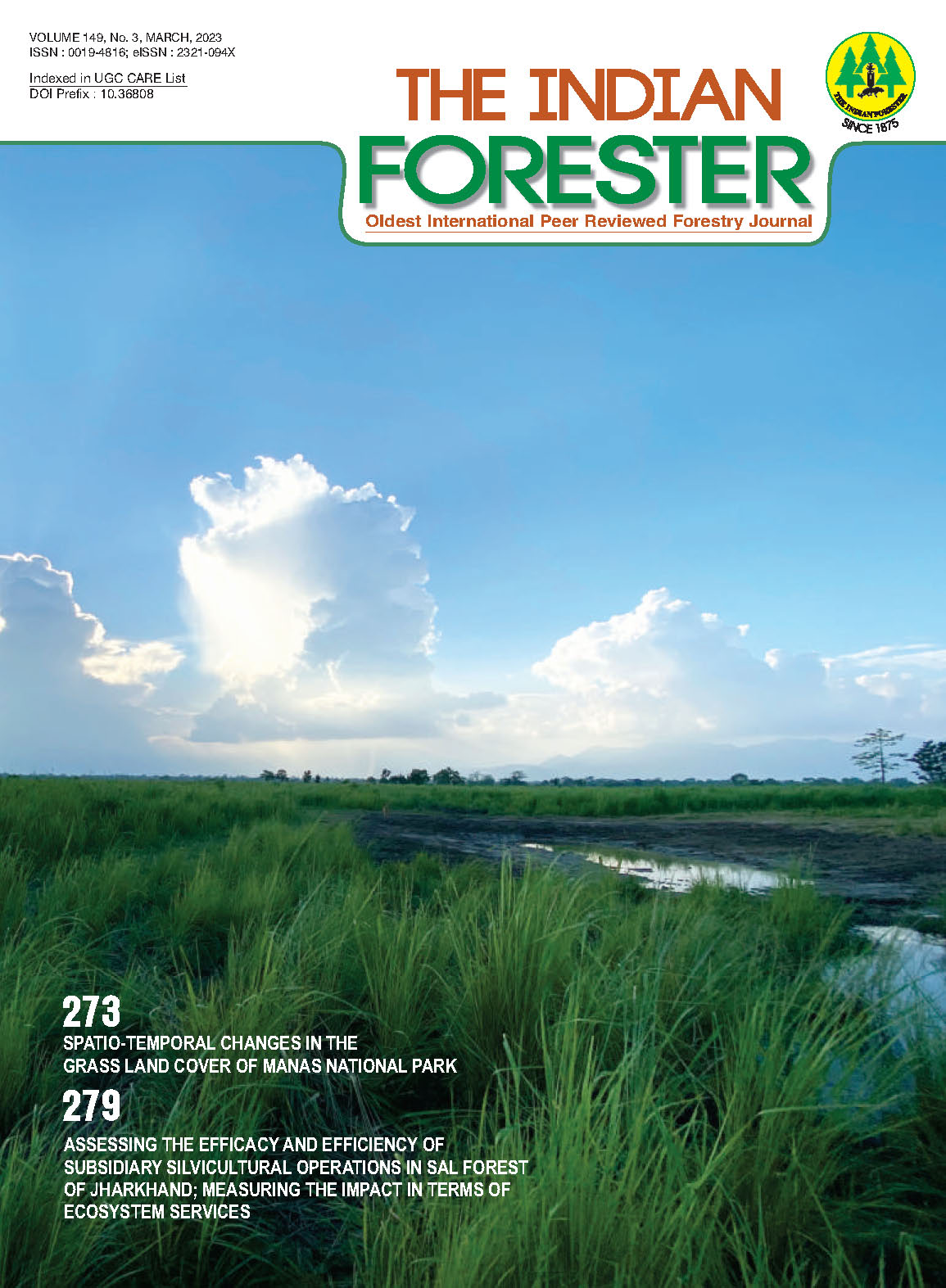Thermal Modification of Bamboo : A Chemical-Free Processing Technique for Improving the Properties and Performance of Products
DOI:
https://doi.org/10.36808/if/2023/v149i3/165210Keywords:
TM Bamboo, Bamboo Timber, Dimensional Stability, Decay Resistance, LBL, BSL.Abstract
Thermal modification is one of the ecofriendly alternative processing techniques for improving various properties of bamboo including dimensional stability and decay resistance. The heat treatment protocols for producing thermally modified (TM) bamboo have been worked out in the laboratory for different species. The TM bamboo exhibited improved properties particularly lower shrinkage and swelling, higher water resistance, darker brownish colour and enhanced decay resistance against fungi and borers. When bamboo is subjected to heat treatment temperatures above 200°C for longer durations (>8 hours), the flexural strength is found to be adversely affected. By thermal processing, not only decay factors of bamboo are eliminated but dimensional stability and resistance to moisture related problems are also improved. TM bamboo with improved aesthetic and quality parameters may be used for production of certain value-added “green productsâ€. A few composite boards were produced successfully in the laboratory using TM bamboo. The bamboo culms of required dimensions were thermally modified and converted into thin strips or crushed bamboo, which can be processed further into sturdy composite panel products such as laminated bamboo lumber (LBL) or bamboo strand lumber (BSL) or so called “bamboo timberâ€. Thus, thermal modification of bamboo may be considered as an ecological alternative to preservative chemical treatments. The thermally modified bamboos may be used for different valued-added products such as furniture, flooring tiles, bamboo boards and strip-based panel products in structural and non-structural industry sectors. Through successful implementation of up-scaled processing, this technique may lead to prospective business opportunities and bamboo-based industry of the country may utilize TM bamboos for production of various life-style products.References
Anon. (1986). IS: 1708. Method of testing of small clear specimens of timber. Bureau of Indian Standards, New Delhi, 64 pp.
Anon. (2008). IS: 6874. Method of tests for bamboo. Bureau of Indian Standards, New Delhi, 9 pp.
Anon. (2016). International ThermoWood Association. Production statistics 2016. International ThermoWood Association, Helsinki, Finland. 7 pp.
Chung K.F. and Chan S.L. (2002). Design of bamboo scaffolds. Technical Report No. 23, International Network for Bamboo and Rattan (INBAR), Beijing, 105pp.
Esteves B.M. and Peirera H.M. (2009). Wood modification by heat treatment: a review. BioResources, 4(1): 370-404.
Gnanaharan R., Mohanan C. and Chand Basha S. (1993). Post-harvest technology of reed bamboo. BIC India Bull, 3(1): 1-6.
Hamid N.H., Sulaiman O., Mohammad A. and Ludin N.A. (2012). The decay resistance and hyphae penetration of bamboo Gigantochloa scortechinii decayed by white and brown rot fungi. International Journal of Forestry Research, Volume 2012, Article ID 572903, 5 pp.
Jimenez J.J.P., Macalinao M.G.M. and Sapin G.N. (2021). Physico-mechanical properties of two Philippine bamboos thermally modified in a steam environment. Philippine Journal of Science, 150(1): 171-182.
Kamarudin N. and Sugiyanto K. (2012). The effect of heat treatment on the durability of bamboo Gigantochloa scortechinii. Journal of Forestry Research, 9(1): 1-5.
Liese W. (1985). Bamboos- Biology silvics, properties, utilization. Schriftenreihe der GTZ, Eschborn, Germany, 132 pp.
Salim R. and Wahab R. (2008). Effect of oil heat treatment on chemical constituents of Semantan bamboo (Gigantochloa scortechinii Gamble). J. Sustainable Development, 1(2): 91-98.
Seethalakshmi K.K., Muktesh Kumar M.S., Sankara Pillai K. and Sarojam N. (1998). Bamboos of India: A Compendium. Technical Report No. 17, Bamboo Information Centre-India, Kerala Forest Research Institute, Peechi and International Network for Bamboo and Rattan, Beijing, 342pp.
Shukla S.R. (2019). Evaluation of dimensional stability, surface roughness, colour, flexural properties and decay resistance of thermally modified Acacia auriculiformis. Maderas. Ciencia y tecnologÃa, 21(4): 433-446.
Shukla S.R. (2020). Thermal modification of bamboos for improving various properties and value-added applications. Project completion report submitted to Karnataka Forest Department, Bangalore, India, 70 pp.
Shukla S.R. and Sharma S.K. (2014). Effect of high temperature processing under different environments on physical and surface properties of Rubber wood (Hevea brasiliensis). Journal of the Indian Academy of Wood Science, 11(2): 182-189.
Shukla S.R. and Sharma S.K. (2018). Effect of high temperature treatment of Hevea brasiliensis on density, strength properties and resistance to fungal decay. Journal of the Indian Academy of Wood Science, 15(1): 87-95.
So M.F. (2002). Erection of bamboo scaffolds and their recent developments. Editor(s): M. Anson, J.M. Ko, E.S.S. Lam, Advances in Building Technology Proceedings of the International Conference on Advances in Building Technology, Elsevier, 4–6 Dec, Hong Kong, China, Vol I: 645-651.
Tewari D.N. (1993). A Monograph on Bamboo, International Book Distributors, Dehra Dun, India, 498pp.
Wang X., Cheng D., Huang X., Song L., Gu W., Liang X., Li Y. and Xu B. (2020). Effect of high temperature saturated steam treatment on the physical, chemical, and mechanical properties of moso bamboo. Journal of Wood Science, 66: 52.
Wei D., Schmidt O. and Liese W. (2013). Durability test of bamboo against fungi according to EN standards. Eur. J. Wood Prod., 71: 551–556.
Zhang Y.M., Yu Y.L. and Yu W.J. (2013). Effect of thermal treatment on the physical and mechanical properties of Phyllostachys pubescen bamboo. Eur. J. Wood Prod., 71(1): 61-67.
Downloads
Downloads
Published
How to Cite
Issue
Section
License
Unless otherwise stated, copyright or similar rights in all materials presented on the site, including graphical images, are owned by Indian Forester.





